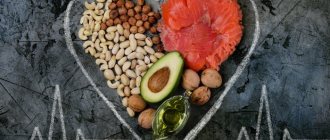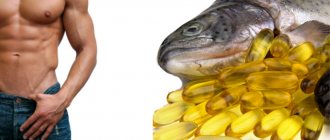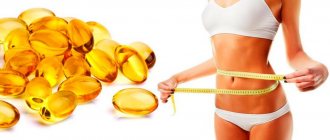December 18, 2022 January 13, 2022
The evidence for the benefits of omega-3 fatty acids is growing every year. Thus, recently, employees of the Faculty of Pharmacy at the University of the Basque Country discovered that omega-3 PUFAs can help with Parkinson’s disease 1, and a team of scientists from Korean universities has proven the effectiveness of acids of this class in the prevention of gastrointestinal cancer 2.
Where can a person get these important substances, what products contain them, and do they all have the same value?
What omega-3-PUFAs are there?
Today there are 11 known omega-3 polyunsaturated fatty acids. 3 of them are indispensable for humans. The remaining 8 are found in food and may have biological effects, but do not play a major role.
The three important omega-3 PUFAs have their own gradation. The simplest of these is alpha-linolenic acid (ALA). In itself, it is not of fundamental importance for health. Its main advantage is that from it the human body is able to synthesize two other omega-3-polyunsaturated fatty acids: eicosapentaenoic acid (EPA) and docosahexaenoic acid (DHA). The processing efficiency is extremely low: on average, only about 5% of ALA is converted into EPA and 0.5% into DHA.
It is EPA and DHA that give omega-3 polyunsaturated fatty acids their health benefits. This reduces the risk of cardiovascular diseases, helps with depression, and has a positive effect on vision. The recommended intake of these acids for an adult is 2 g per day.
An article about why omega-3 PUFAs are especially important for women.
Thus, the question “What do omega 3-PUFAs contain?” it is appropriate to consider separately for each of the three significant acids: ALA, EPA and DHA.
These products may interest you
How to use
How to take omega-3 fatty acids correctly? First you need to decide on the dosage and source.
Source
The best natural source is sea fish. Flaxseed oil or fish oil capsules are suitable supplements.
Important: do not buy flaxseed oil in stores, since if stored improperly, its benefits for an athlete (and even an ordinary person) are practically absent.
© VadimVasenin — depositphotos.com
Dosage
Once you have decided on the source, you need to figure out the dosage. The classic 6:1:1 scheme (omega 3-6-9, respectively) is not suitable for everyone. In traditional dietary patterns, fat accounts for about 20 g of total nutrition per day. Accordingly, 12 of them are omega-3 and the remainder is evenly distributed among other types of polyunsaturated acids, excluding trans fats and fats of a complete complex form.
What to do if you like to eat fried potatoes or eat a lot of pork, and the total amount of fat per day exceeds 60, or even 100 grams? In this case, a dosage regimen is used in which the amount of omega-3 will be at least half the amount of omega-6.
Since not all fat is digested, omega-3 provides exactly the right reaction so that all digested fat (about 35% of that obtained with such a diet) goes into the correct biochemical reactions.
Therefore, you select the dosage according to your diet and calorie intake. When consuming fat in moderation, try to stick to the 6:1:1 formula. At elevated levels – at least 3:6:1. However, it will be beneficial for your health to reduce excess fat in your diet.
How to take omega-3 and when is the best time to do it? There are no special recommendations in this regard. There are only caveats:
- Do not consume after consuming trans fats. In this case, omega-3 will only complete the form of adipose tissue, which will increase toxicity upon further breakdown.
- Do not use on an empty stomach. The fragile structure of the molecules allows the body to convert triglyceride into glucose with minimal effort, which will reduce the effect of omega-3 to zero.
- Do not mix with carbohydrates. This increases the likelihood that fatty acids will be sent directly under your skin under the influence of an intense insulin response.
The optimal solution would be to divide the recommended dosage into 2-3 times (to reduce the load on the gastrointestinal tract) and use it together with transport proteins to quickly stabilize the cholesterol reaction.
What foods contain the omega-3 PUFA alpha-linoleic acid?
There are a number of plant foods that contain large amounts of ALA. These are nuts (especially walnuts), soy, flax and chia seeds. The ALA concentration in Brussels sprouts is slightly lower, but this vegetable is easily accessible and well suited for the daily diet. In addition to ALA, the foods listed are rich in fiber and minerals.
Some types of vegetable oils can also boast high levels of ALA: flaxseed, mustard, perilla. They should be used when preparing cold dishes, for example, added to salads or sauces. When heated, omega-3 PUFAs are destroyed, so frying in such vegetable oils is not recommended.
However, due to the low efficiency of converting ALA into EPA and DHA, these products are not able to provide the recommended daily intake of omega-3 PUFAs. Walnuts, flaxseed and others can only be considered as an addition to the diet.
Rules for use by children and pregnant women
2.2-2.5 grams to the child during pregnancy . That is why women during pregnancy and children should actively take fish containing Omega-3 fatty acids. However, you should avoid eating king mackerel and swordfish due to their high mercury content. Children deserve special attention. They should take supplements under the supervision of medical professionals or parents to avoid overdose.
Omega-3 fatty acids also have a number of contraindications . They are not recommended for people with blood thinning diseases. If you are predisposed or have such a disease, you should consult your doctor.
Which foods contain omega-3 PUFAs eicosapentaenoic and docosahexaenoic acids?
EPA and DHA go hand in hand and are found in the same foods. These are seafood: fish and their caviar, shellfish. It is curious that the fish itself does not synthesize omega-3 PUFAs, but obtains them from underwater vegetation. We can do the same by eating seaweed that is edible for humans - for example, chuka or seaweed.
If you consume a portion of mackerel, salmon, herring, oysters several times a week, you can completely solve the problem of a lack of omega-3 PUFAs in the body. Seafood is also rich in selenium and B vitamins.
Functions in the human body
Omega-3s literally help maintain and increase health, as they:
- They take part in the synthesis of eicosanoids (tissue hormones), which regulate intracellular metabolism.
- Reduce the risk of heart attack and stroke by lowering blood cholesterol levels.
- They are an important component of the tissues of the nervous system.
- Take part in the formation of sperm.
- They regulate the production of many hormones, including testosterone.
- They help cope with psycho-emotional overloads and prevent the development of depressive states.
- They prevent the occurrence of allergies and the development of autoimmune processes due to their anti-inflammatory properties.
- Improves memory and attention.
- Have a beneficial effect on the condition of the skin.
- Reduces the level of stress hormone cortisol.
In addition to all of the above, omega-3s are needed by everyone who wants to lose weight and is actively involved in sports: they promote fat burning and help build lean muscle mass. Fatty acids of this class are also useful for patients with chronic arthritis and arthrosis, as they improve the elasticity of joints.
Table of Omega-3 acids content in 3 products
Data on the amount of essential omega-3 PUFAs in popular foods are shown in the table.
| Product | What acid does it contain? | Content per 100 g of product, mg | Additionally |
| Mackerel | EPA+DHA | 5 134 | 100 g of mackerel contains 200% of the daily value of vitamin B12 and 100% of selenium |
| Salmon | EPA+DHA | 2 260 | Contains high-quality protein, large amounts of magnesium, potassium, selenium and B vitamins |
| Herring | EPA+DHA | 1 729 | 100 g of herring contains 400% of the daily value of vitamin D, 200% of vitamin B12 and 50% of selenium |
| Oysters | EPA+DHA | 672 | Oysters contain more zinc than any other food - 600% of the daily value per 100 g, as well as 200% copper and 300% vitamin B12 |
| Sardines | EPA+DHA | 1 480 | 100 g of sardines contain 150% of the daily value of vitamin B12 and 75% of selenium |
| Tuna | EPA+DHA | 1 664 | 100 g of tuna contains 180% of the daily value of vitamin B12 and 65% of selenium |
| Anchovies | EPA+DHA | 2 113 | Product rich in vitamin B3, selenium and calcium |
| Red and black caviar | EPA+DHA | 6 789 | High content of vitamins B4 and B12 |
| Flax-seed | ALC | 2 2813 | Very rich in fiber, vitamin E, magnesium |
| Chia seeds | ALC | 17 552 | High level of minerals: calcium, manganese, phosphorus |
| Walnuts | ALC | 9 079 | Contains a lot of fiber, copper, manganese, vitamin E |
| Soya beans | ALC | 1 443 | Source of potassium, magnesium and vitamins B2, B9, K |
| Brussels sprouts | ALC | 173 | Source of vitamins C and K |
Signs of shortage
Symptoms of omega-3 deficiency include:
- Dry skin and hair, brittle nails.
- Persistent thirst.
- Lack of strength, lethargy and drowsiness, depression.
- Deterioration of memory and attention.
- Decreased immunity, which is manifested primarily by frequent acute respiratory viral infections and colds.
In infants and preschool children, a lack of omega-3 fatty acids results in mental retardation.
Despite the fact that omega-3s are very useful, if they are taken uncontrolled, an overabundance of these substances can occur. This condition manifests itself as constant diarrhea, low blood pressure, and decreased blood clotting.
Maintain balance
Omega-3 acids perform a number of functions in the body:
- Reduces bad cholesterol levels.
- They thin the blood, which means they reduce the risk of thrombosis.
- Dilate blood vessels.
- Reduce inflammatory reactions.
- Increases resistance to stress.
- Strengthens cell membranes.
As for omega-6 acids, they have the exact opposite effect: they constrict blood vessels, thicken the blood, reduce immunity, and promote the development of inflammatory processes. Therefore, large amounts of omega-6 acids can be harmful. But you cannot refuse them, because otherwise the body will not receive the essential linoleic acid, without which it is impossible to maintain health. Omega-9 acids are close in their effect to omega-6, so they should not be abused either.
It is important to maintain a certain balance between the consumption of omega-3 and the total amount of omega-6 and omega-9 in the diet. The correct ratio is 1 to 3–4 in favor of omega-6 and omega-9.
Medicines from a plate. What products will replace tablets Read more
Interaction with other vitamins
There are many vitamins and minerals available, but the ones I tested for compatibility with omega-3 are the essential ones, which are the most important for the body and are most often taken in supplement form. The compatibility level of the elements is indicated in the left column. If you need to take vitamins that are not compatible with omega-3s, take them at different times of the day (for example, morning and evening).
| Compatibility | Nutrients |
| High | E, K, B2, B6, B9 (folic acid), B12, coenzyme Q10, lecithin |
| Neutral | A, B1, B3, B5, C, D, K, magnesium, zinc, selenium |
| Low | B7 (biotin), calcium, iron, copper, chromium |
You should not drink alcohol while taking omega-3. Drinking alcohol destroys liver enzymes involved in the breakdown of polyunsaturated fatty acids.
Use foods rich in vitamins; give preference to minimally processed vegetables. A variety of salads with added vegetable oils and seeds will reduce your need for fatty acids. Be sure to get tested regularly to monitor your vitamin levels and keep up with the supplements you need for your health and wellness.
Contraindications and possible harm
In some cases, taking such supplements is prohibited:
- If there is an excess of vitamin E in the body.
- When treated with drugs containing a high content of this vitamin.
- In case of intolerance to certain components or allergy to fatty acids.
Excessive consumption of this substance in large doses can lead to malfunctions of the body. Therefore, it is necessary to control the rate of consumption of this substance.
An excess of omega 3 can cause excessive blood thinning, which means an increased risk of vascular rupture and disruption of other organs.
It should be remembered that this applies to both adults and children. Therefore, it is worth discussing with your pediatrician the possibility of taking dietary supplements and their dosage.











